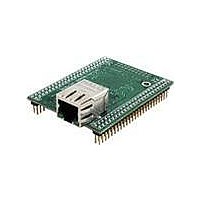MOD5234-100IR NetBurner Inc, MOD5234-100IR Datasheet - Page 484

MOD5234-100IR
Manufacturer Part Number
MOD5234-100IR
Description
MOD5234 10/100 ETHERNET MODULE
Manufacturer
NetBurner Inc
Type
Controllers & Processorsr
Datasheets
1.MOD5272-100IR.pdf
(3 pages)
2.MOD5234-100IR.pdf
(4 pages)
3.MOD5234-100IR.pdf
(754 pages)
Specifications of MOD5234-100IR
Interface
I²C, SPI, UART
Voltage - Supply
2.5V
Mounting Type
Surface Mount
Package / Case
Module
Product
Modules
Lead Free Status / RoHS Status
Lead free / RoHS Compliant
Data Format
-
Baud Rates
-
Lead Free Status / Rohs Status
Lead free / RoHS Compliant
Other names
Q4483564
- Current page: 484 of 754
- Download datasheet (13Mb)
FlexCAN
21.4.7 Time Stamp
The value of TIMERn is sampled at the beginning of the identifier field on the CAN bus. For a
message being received, the time stamp will be stored in the TIMESTAMP entry of the receive
message buffer at the time the message is written into that buffer. For a message being transmitted,
the TIMESTAMP entry will be written into the transmit message buffer once the transmission has
completed successfully.
The free-running timer can optionally be reset upon the reception of a frame into message buffer
0. This feature allows network time synchronization to be performed. See the
CANCTRLn[TSYN] bit.
21.4.8 Bit Timing
The FlexCAN module CANCTRLn register configures the bit timing parameters required by the
CAN protocol. The CLK_SRC, PRESDIV, RJW, PSEG1, PSEG2, and the PROPSEG fields allow
the user to configure the bit timing parameters.
The CANCTRLn[CLK_SRC] bit defines whether the module uses the internal bus clock or the
output of the crystal oscillator via the EXTAL pin. The crystal oscillator clock should be selected
whenever a tight tolerance (up to 0.1%) is required for the CAN bus timing. The crystal oscillator
clock has better jitter performance than PLL generated clocks. The value of this bit should not be
changed unless the module is in disable mode (CANMCRn[MDIS] bit is set)
The PRESDIV field controls a prescaler that generates the serial clock (S-clock), whose period
defines the “time quantum” used to compose the CAN waveform. A time quantum is the atomic
unit of time handled by the CAN engine.
A bit time is subdivided into three segments
21-30
1.For further explanation of the underlying concepts please refer to ISO/DIS 11519–1, Section 10.3. Reference also the
• SYNC_SEG: This segment has a fixed length of one time quantum. Signal edges are
• Time Segment 1: This segment includes the Propagation Segment and the Phase Segment
Bosch CAN 2.0A/B protocol specification dated September 1991 for bit timing.
expected to happen within this section
1 of the CAN standard. It can be programmed by setting the PROPSEG and the PSEG1
Internal Bus Clock (f
Oscillator Clock (EXTAL)
Figure 21-12. CAN Engine Clocking Scheme
sys/2
)
CANCTRLn[CLK_SRC]
MCF5235 Reference Manual, Rev. 2
1
0
1
(reference
Figure 21-13
Prescaler
(1 .. 256)
and
Table
Freescale Semiconductor
21-15):
S clock
Related parts for MOD5234-100IR
Image
Part Number
Description
Manufacturer
Datasheet
Request
R

Part Number:
Description:
MCU, MPU & DSP Development Tools MOD5234 MODULE
Manufacturer:
NetBurner Inc
Datasheet:

Part Number:
Description:
MCU, MPU & DSP Development Tools MOD5234 Core Module Development Kit
Manufacturer:
NetBurner Inc
Datasheet:

Part Number:
Description:
BOARD SERIAL-ETHERNET 512K FLASH
Manufacturer:
NetBurner Inc
Datasheet:

Part Number:
Description:
PROCESSOR MODULE FLASH MOD5272
Manufacturer:
NetBurner Inc
Datasheet:

Part Number:
Description:
PROCESSOR MODULE 512KB FLASH
Manufacturer:
NetBurner Inc
Datasheet:

Part Number:
Description:
DUAL PORT SERIAL-ETHERNET
Manufacturer:
NetBurner Inc
Datasheet:

Part Number:
Description:
PROCESSOR MODULE FLASH
Manufacturer:
NetBurner Inc
Datasheet:

Part Number:
Description:
PROCESSOR MODULE 512KB FLASH
Manufacturer:
NetBurner Inc
Datasheet:

Part Number:
Description:
KIT DEVELOP NETWORK FOR MOD5282
Manufacturer:
NetBurner Inc
Datasheet:

Part Number:
Description:
KIT DEVELOP NETWORK FOR MOD5272
Manufacturer:
NetBurner Inc
Datasheet:

Part Number:
Description:
DUAL PORT SERIAL-ETHERNET
Manufacturer:
NetBurner Inc
Datasheet:

Part Number:
Description:
Ethernet Modules & Development Tools 32 Bit 66MHz 40 Pin DIP Industrial Temp
Manufacturer:
NetBurner Inc
Datasheet:

Part Number:
Description:
Ethernet ICs 32bit 147MHz CAN-to- Ethnt Device IndTemp
Manufacturer:
NetBurner Inc
Datasheet:










